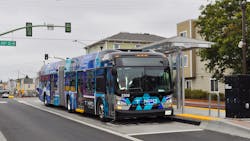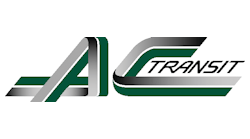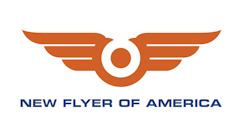The Alameda-Contra Costa Transit District (AC Transit) started service Aug. 9 on Tempo, the first bus rapid transit (BRT) line for the East Bay connecting Uptown Oakland to the San Leandro Transit Center.
Tempo replaces AC Transit’s Bus Line 1 along International Boulevard where it will run 24 hours a day. Riders can expect a Tempo bus every 10 minutes between 6:00 a.m. and 7:00 p.m.; every 15 minutes between 7:00 p.m. and midnight; and every 60 minutes between midnight and 5:59 a.m.
“The AC Transit board of director’s greenlit Tempo seeking more than a new bus line,” said Board President Joe Wallace. “We sought a new way to deliver innovation, jobs to East Bay workers and a commitment to inclusion and diversity; all the while ensuring our riders, merchants, and city, state and federal partners had an active voice from design to final construction. And AC Transit’s staff made it happen. That’s why we are proud to launch Tempo.”
The $232-million project features a nearly 10-mile network of dedicated and painted bus-only lanes, 46 curbside and center median stations and 27 new 60-foot hybrid buses from New Flyer.
AC Transit says the new buses were made with lighter weight components to promote fuel savings and come equipped with hybrid technology to reduce particulate and nitric oxide emissions. Embedded technology allows the Tempo coach to kneel to variable heights and minimizes the slope difference between the platform and bus floor.
Each vehicle has five doors, a seating capacity for 58 riders and a standing capacity for 38. The front doors will be used in emergencies, the middle doors are equipped with bridge plates to ensure smooth boarding for riders with mobility devices and the back doors can be used by cyclists to access the interior bike racks.
The buses are also equipped with onboard forward-facing cameras to capture images of violations in the bus-only lanes.
“Tempo represents a tangible commitment to our neediest riders along International Boulevard and East 14th Street to replace Bus Line 1,” says General Manager Michael Hursh. “Line 1 was stalled by heavy traffic, which created bus bunching and undermined on-time performance, rendering Line 1 unreliable. The bus-only lanes now bypass traffic bottlenecks, eliminates bunching and by managing traffic signals through transit signal priority technology, Tempo will ultimately achieve its optimal frequencies of a bus every 10-minutes.”
The new Tempo BRT stations have overhead variable message signs, real-time audio push buttons to assist vision impaired riders, platform-mounted ticket vending machines and Clipper card readers, among other safety features.
Tempo will be fare free the first 90 days, but fares will apply starting in November when riders can pay prior to boarding a bus.
Tempo by the Numbers
- 8 miles of new safety enhanced bike lanes.
- 9.5 miles of new curb-to-curb pavement and dedicated bus-only lanes.
- 11 platforms feature windscreens with commissioned artwork by local artists.
- 13 miles of fiber optic cabling power the Tempo system.
- 27 60-foot hybrid technology coaches.
- 35 new traffic signals that improve bus frequency.
- 46 stations with iconic canopies; ADA accessible station sidewalks and ramps; LED lighting, overhead variable message signs, platform seating, and Real-Time Audio for the visually impaired; Clipper card readers and ticket vending machines; map cases and wayfinding signs.
- More than 450 new high visibility crosswalks for pedestrian safety.
- 515 new curb ramps allow walking along Tempo’s corridor easier for people using mobility devices and strollers.

Mischa Wanek-Libman | Group Editorial Director
Mischa Wanek-Libman is director of communications with Transdev North America. She has more than 20 years of experience working in the transportation industry covering construction projects, engineering challenges, transit and rail operations and best practices.
Wanek-Libman has held top editorial positions at freight rail and public transportation business-to-business publications including as editor-in-chief and editorial director of Mass Transit from 2018-2024. She has been recognized for editorial excellence through her individual work, as well as for collaborative content.
She is an active member of the American Public Transportation Association's Marketing and Communications Committee and served 14 years as a Board Observer on the National Railroad Construction and Maintenance Association (NRC) Board of Directors.
She is a graduate of Drake University in Des Moines, Iowa, where she earned a Bachelor of Arts degree in Journalism and Mass Communication.





